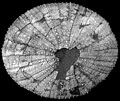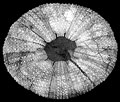The Echinoid Directory
Contributed by Ildefonso Bajo Campos, November 2009
Tripneustes gahardensis (Seunes, 1896, p. 84)
[1884 Hipponoe sp. Bazin: 36, pl. 1, figs. 22-25.
1896 Hipponoe parkinsoni var. gahardensis Seunes: 84-86, pl. 1, fig. 1.
1906 Tripneustes gahardensis (Seunes): Lambert 75-77; fig. 1; pl. 5, figs. 12-13.
2009 Tripneustes gahardensis (Seunes): Bajo & Borghi 11-20; pl. 1, figs 1a-c, pl. 2, figs. 1a-c, 2a-c.]
| Diagnostic Features |
|
|---|---|
| Distribution | Middle Miocene of France; Middle Miocene and upper Tortonian of Spain. |
| Type | Whereabouts unknown. |
| Classification and/or Status | A species of Tripneustes |
| Remarks | Differs from Tripneustes planus by its larger size and less depressed test outline. The interporiferous tubercles are less developed, primary and secondary tubercles are more homogeneous and numerous. In T. planus the interambulacral areas are somewhat depressed aborally and the interambulacral plates are proportionally taller than those of T. gahardensis. Differs from T. ventricosus by the less dense secondary tuberculation and the occurrence of aboral naked interradial zones aborally. In T. gahardensis the ambulacral areas are narrower than the interambulacral ones also near the peristome, and the buccal notches are more developed. Bajo, I. & Borghi, E. 2009. Tripneustes gahardensis (Echinoidea) en el Mioceno de la Cuenca del Guadalquivir. Batalleria, 14: 11-20. |


